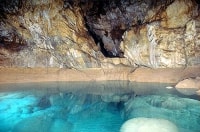Visit to the Cave of the Lakes - Ancient Lousoi – Sinkholes
About 16 kilometers south of Kalavryta on the road to Kastria, there is one of the most unique caves in the world, with its multiple, staggered lakes (13 have been recorded), the Cave of the Lakes (or Kastrion). Of old, the cave had much more water, but today it maintains its beauty and glamour. It has a total length of 1,980 meters and is accessible up to 500 meters. Human and animal bones have been found in the cave. It was developed as a tourist attraction in 1981.

Three kilometers before the caves, as we head down the road from Kalavryta to Kastria near Kato Lousoi, it is worth to making a detour to the right to visit the Lousoi Plain, ancient Lousoi, the sinkhole of the valley, and Kaliakoudotrypa cave.
From Kato Lousoi, head right to ancient Lousoi and Lousiko. Along the way we pass through a wide green valley called Epano Kampos (which means Upper Plain). In the area of Lousiko, between the ancient cities of Kleitor (or Cleitor or Kleitoras) and Cynaetha, there was an important city in antiquity, Lousoi, which was known since the year 708 BC and the Olympic champion Euryvatos. Today many findings from the ancient city have been excavated on the plain of Lousoi, the most important being the foundations of buildings and the temple of Artemis Hemerasias (Artemis of the dawn), on the left as we go up to Lousiko.
To visit the sinkhole, just before we turn left toward Ancient Lousoi and the village of Lousiko, we look to our left for the Kalavryta Municipality’s information kiosk about the Chelmos-Vouraikos National Park, which informs us about the sights of the area: to begin with, Ancient Lousoi, and then two geological points of interest, the sinkholes and the Kaliakoudotrypa cave. The large sinkhole is 200 meters from the kiosk, on a dirt road that heads off to the left. This sinkhole drains the Lousoi plain, which often floods in the winter and becomes a large lake. Iron bars have been placed at the entrance to the sinkhole for safety reasons. This is the largest sinkhole, but not the only one. There are others a little to the right, at the bottom of the rocks that stand in front of us.
150 meters east of the large sinkhole in the Lousoi plain, in the forest that starts above the sinkhole, we find the impressive Kaliakoudotrypa, a cave whose name means “jackdaw hole.” You will not find it easily without a guide or the GPS position of EG, as the path has closed over, and the whole area is swamped in fir trees, branches, and dense undergrowth. This is the mouth of a large cave with an area of about 360 square meters, decorated with stalagmites and stalactites. Kaliakoudotrypa was explored in 1972 by a team of the Hellenic Speleological Society headed by Anna Petrochilou and Ioannis Ioannou, who also mapped out the cave. It took its name because jackdaws used to live there ("black blackness fell, black as a jackdaw").







